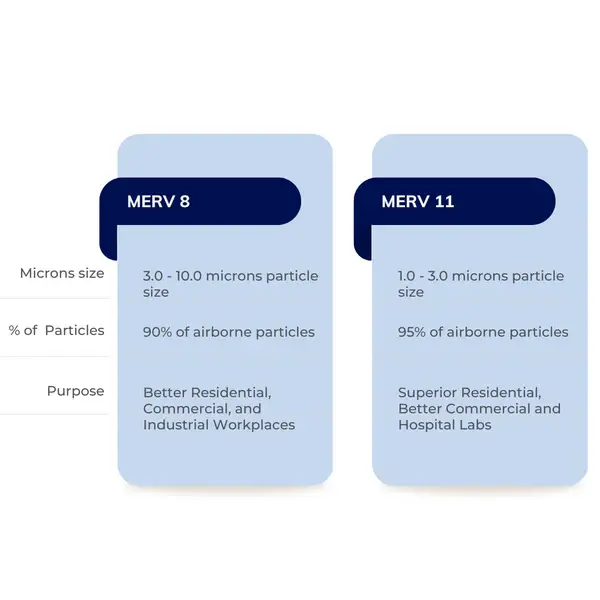MERV 8 vs MERV 11: Which is Better?
- Jennifer Crowley
- Jul 28, 2023
- 4 min read
Updated: Jul 9, 2024

MERV (Minimum Efficiency Reporting Value) is a rating system that measures the effectiveness of air filters in capturing particles of different sizes. The MERV rating scale ranges from 1 to 20, with higher numbers indicating greater efficiency in capturing smaller particles.
In this blog post, we will compare two standard MERV ratings for air filters: MERV 8 vs MERV 11. We will discuss the pros and cons of each type, their particle capture capabilities, air flow rates, pressure drops, and costs, as well as provide guidance on choosing between the two.
What is MERV 8?
MERV 8 filters can capture particles that are 3 to 10 microns in size, such as
Pollen
Dust mites
Pet dander
They are less expensive and allow for higher airflow rates than higher MERV-rated filters, making them a good choice for systems with high airflow needs. However, MERV 8 filters may not capture smaller particles that can cause respiratory problems, such as mould spores and bacteria. They must also be changed more frequently than higher-rated filters to maintain effectiveness.
What is MERV 11?
MERV 11 filters can capture particles that are 1 to 3 microns in size, such as:
Pollen
Dust mites
Mould
Large dust particles
Auto emissions
Fine air particles
Pet dander
Lint
Smoke
Smog
Bacteria
MERV 11 filters offer better filtration than MERV 8 filters and can help improve indoor air quality for people with allergies or respiratory problems. However, they are also more expensive and can restrict airflow more than MERV 8 filters. When the airflow is restricted, it can lead to discomfort, higher energy consumption, and faster wear and tear of HVAC equipment. Using an air filter with a MERV rating that exceeds your system’s recommended level can be particularly damaging, causing harm to the compressor, heat exchanger, and air conditioner coil.
Comparison of MERV 8 vs MERV 11
When comparing MERV 8 and MERV 11 filters, it is important to consider their particle capture capabilities, air flow rates, pressure drops, and costs.

Particle capture capabilities: MERV 11 filters more effectively capture smaller particles than MERV 8 filters. This means they can help improve indoor air quality and reduce the risk of respiratory problems. However, MERV 8 filters may be sufficient for capturing larger particles like pollen and dust, which can also contribute to indoor air pollution.
Air flow rates: MERV 8 filters allow for higher airflow rates than MERV 11 filters. This means they may be a better choice for standard HVAC systems with high airflow needs, such as commercial buildings that don’t require superior air filtration. MERV 11 filters can restrict airflow more than MERV 8 filters, which can cause strain on HVAC systems and potentially increase energy costs.
Pressure drops: MERV 11 filters can cause higher pressure drops than MERV 8 filters, further straining HVAC systems and reducing energy efficiency. Choosing the right filter for the specific system is essential to avoid this issue.
Costs: MERV 11 filters are generally more expensive than MERV 8 filters, which can be a factor for those on a tight budget. Additionally, MERV 11-rated filters get clogged much more quickly than a MERV 8 filter and have to be replaced frequently.
How to Choose Between MERV 8 and MERV 11?
When choosing between MERV 8 and MERV 11 filters, it is crucial to consider the HVAC system’s and its occupants’ specific needs. Here are some factors to consider:
Types of particles present: If your system needs to capture smaller particles like mould spores or bacteria, a MERV 11 filter may be more appropriate. If it only needs to capture larger particles like pollen and dust, a MERV 8 filter may suffice.
Air flow rate required: If your system requires high air flow rates, a MERV 8 filter may be a better choice. However, if indoor air quality is a higher priority and airflow rates can be sacrificed, a MERV 11 filter may be a better choice.
Budget available: A MERV 8 filter may be more cost-effective if the budget is a concern. However, if indoor air quality is a higher priority and a higher initial cost can be justified, a MERV 11 filter may be a better choice in the long run.
Occupant health concerns: If occupants have allergies or respiratory problems, a MERV 11 filter may be more appropriate to help improve indoor air quality and reduce the risk of health issues. However, if no health concerns are present and your system only needs to capture larger particles, a MERV 8 filter may be sufficient.
In summary, MERV 8 and MERV 11 filters both have their advantages and disadvantages and choosing between them depends on your HVAC system’s specific needs and occupants. While MERV 11 filters offer better particle capture capabilities and improved indoor air quality, they also come with higher costs and potential airflow restrictions. On the other hand, MERV 8 filters allow for higher air flow rates and are more cost-effective but may not capture smaller particles that can cause health problems. It is important to weigh these factors carefully and consult a professional to determine the best filter for your system.





















